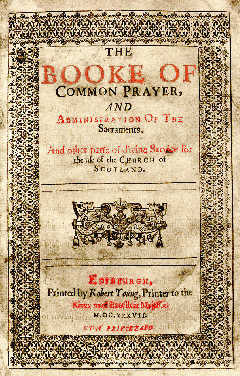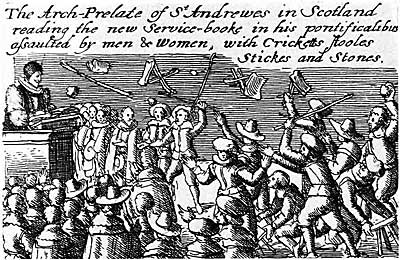The
1637 Scottish Book of Common Prayer

King Charles I, and his father King James before him, had throughout their
reigns wished to prescribe fixed forms of liturgy and prayer (as had long
been in place in England) to their native Scotland.
This was, as any student of history should know,
a time of great religious upheaval and controversy. In Britain the forces
of the Anglican Church were striving to maintain their relatively traditional
liturgy against the rising tide of the Puritans in England and Presbyterians
in Scotland, who both wished a state religion which was much more "Protestant"
in character. In the background there was the always-present danger of
a return to the Papacy.
King Charles was firmly of a mind to extend Anglican
forms to Scotland, particularly as expressed in the Book of Common Prayer,
and the great majority of the Scottish people were equally determined
to resist. Charles was not one for compromise, and so had the Scottish
Bishops, with the approval of Archbishop William Laud, draw up a Book of Common Prayer for Scotland.
This Book was promulgated in 1637 and was immediately denounced by the
Scottish people; it was never even put into use.
 |
|
|
|
This was one of the more important of the events
which led to the Puritan Revolution of 1645, and Charles' overthrow and
eventual beheading.
 |
A
1712 reprint of the 1637 Scottish BCP. |
If
that was all there was to this book, it would likely be only an historical
curiosity. However, after the "Glorious Revolution" of 1688
which overthrew James II and brought William and Mary to the throne, the
Church of Scotland was delivered firmly into the hands of the Presbyterians,
leaving those who preferred Anglican forms with no home. These formed
the Scottish Episcopal Church, and began to take as their Prayer Book
the old 1637 Scottish Book of Common Prayer. It was reprinted several
times in the 1700's, and by the mid to late 18th century forms based on
this book were in common use in the Scottish Episcopal Church. So when
Samuel Seabury came in 1784 to the Scottish Church to be ordained the
first American bishop, he was urged to take these Scottish forms as the
basis for the American Episcopal liturgy. He did, and as a result this
book can be seen as a direct ancestor of the American Book of Common Prayer
- particularly with regards to the Communion Service. We have online the
1764 Communion Office of the Scottish
Episcopal Church - the successor to the one in this book, and the predecessor
of the one in the first U. S. Book of Common Prayer, and also Seabury's
nearly identical Communion Service, which
he used as Bishop of Connecticut.
The book is basically
a moderate revision of the then-current Prayer Book: the Book of 1559, as
revised in 1604. There were a large number of changes, but the vast majority
of them are quite minor. The more significant changes include:
- Most (but by
no means all) of the scripture readings from the Apocrypha were removed
as a concession to the Presbyterians.
- Another concession
was the use of the term "Presbyter" to replace "Priest"
or "Minister".
- The Communion
Service was rearranged significantly to bring it to be more in line
with the original 1549 Book.
- The water of the
baptismal font was directed to be changed at least once a month, and
a form of blessing provided for the new water.
- Biblical texts
were taken for the first time from the Authorized, or King James Version
of the Bible.
- The general tone
of the book, particularly in its rubrics, is more prescriptive.
These
changes may be seen by comparing this text with that of the 1559 Book. This book is listed in David
Griffiths' Bibliography of the Book of Common Prayer as 1637/9. The Internet Archive has two copies (both from the Benton Collection at the BPL) available as PDF graphics: copy 1; copy 2.
The
Communion Service is also online in
modern spelling. Two identical reprints (from 1904
and 1909)
of this book (Griffiths 1904/6) with a lengthy introduction by James
Cooper are available from Google Books in PDF graphics and plain text
formats. Google Books also has the
1712 reprint pictured above as PDF graphics (Griffiths 1712/7). We also have online Scottish Liturgies of the Reign of James VI, which presents a very different and much earlier draft of this book, along with an extensive historical introduction and commentary.
Notes on the
text:
The basic text was first taken from either a reprint of the 1559
BCP, or from Liturgiae Britannicae, by William Keeling (Pickering,
London, 1851). This text was then compared with an actual copy of the
original, and changed to agree with the original wherever necessary.
My copy of the original 1637 text has three or four pages missing; in
those cases, the comparison was made instead with a 1712 reprint (title
page above, Griffiths 1712/7). The original text used Roman type for headings
and the rubrics, and blackletter ("Old
English") for the basic text of the services. Since blackletter
is not a font commonly found on computers (and isn't particularly readable
anyway), we have replaced the blackletter of the original with Roman,
and replaced the Roman font of the rubrics with italics. The original
spelling and punctuation has been maintained throughout (the 1712 reprint
updates the spelling, but not punctuation or capitalization). There are
several pictures of pages of the original so you can see just what it
actually looks like. Additionally, a PDF graphics version is available from the Internet Archive.
It is
to be expected that this edition, which is nearly 400 years old, uses
some archaic English words. What might not be expected is that certain
words used here have entirely different meanings nowadays than they did
in the 1600's. The meanings of any particularly unusual words, or words
whose meaning is very different today, are given in the text.
|
(photo by web author)